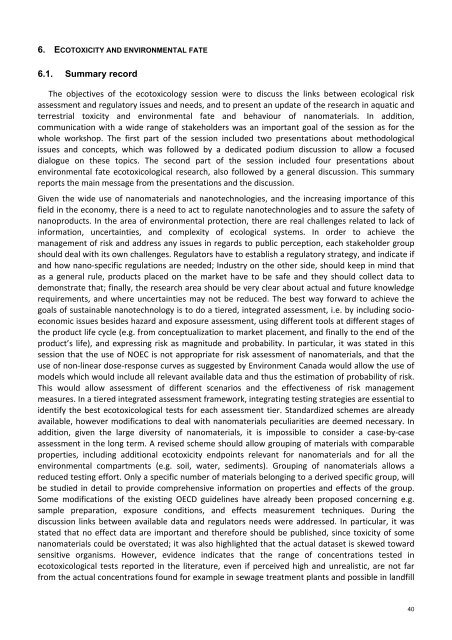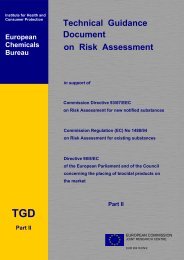Challenges of Regulation and Risk Assessment of Nanomaterials
Challenges of Regulation and Risk Assessment of Nanomaterials
Challenges of Regulation and Risk Assessment of Nanomaterials
Create successful ePaper yourself
Turn your PDF publications into a flip-book with our unique Google optimized e-Paper software.
6. ECOTOXICITY AND ENVIRONMENTAL FATE<br />
6.1. Summary record<br />
The objectives <strong>of</strong> the ecotoxicology session were to discuss the links between ecological risk<br />
assessment <strong>and</strong> regulatory issues <strong>and</strong> needs, <strong>and</strong> to present an update <strong>of</strong> the research in aquatic <strong>and</strong><br />
terrestrial toxicity <strong>and</strong> environmental fate <strong>and</strong> behaviour <strong>of</strong> nanomaterials. In addition,<br />
communication with a wide range <strong>of</strong> stakeholders was an important goal <strong>of</strong> the session as for the<br />
whole workshop. The first part <strong>of</strong> the session included two presentations about methodological<br />
issues <strong>and</strong> concepts, which was followed by a dedicated podium discussion to allow a focused<br />
dialogue on these topics. The second part <strong>of</strong> the session included four presentations about<br />
environmental fate ecotoxicological research, also followed by a general discussion. This summary<br />
reports the main message from the presentations <strong>and</strong> the discussion.<br />
Given the wide use <strong>of</strong> nanomaterials <strong>and</strong> nanotechnologies, <strong>and</strong> the increasing importance <strong>of</strong> this<br />
field in the economy, there is a need to act to regulate nanotechnologies <strong>and</strong> to assure the safety <strong>of</strong><br />
nanoproducts. In the area <strong>of</strong> environmental protection, there are real challenges related to lack <strong>of</strong><br />
information, uncertainties, <strong>and</strong> complexity <strong>of</strong> ecological systems. In order to achieve the<br />
management <strong>of</strong> risk <strong>and</strong> address any issues in regards to public perception, each stakeholder group<br />
should deal with its own challenges. Regulators have to establish a regulatory strategy, <strong>and</strong> indicate if<br />
<strong>and</strong> how nano-specific regulations are needed; Industry on the other side, should keep in mind that<br />
as a general rule, products placed on the market have to be safe <strong>and</strong> they should collect data to<br />
demonstrate that; finally, the research area should be very clear about actual <strong>and</strong> future knowledge<br />
requirements, <strong>and</strong> where uncertainties may not be reduced. The best way forward to achieve the<br />
goals <strong>of</strong> sustainable nanotechnology is to do a tiered, integrated assessment, i.e. by including socioeconomic<br />
issues besides hazard <strong>and</strong> exposure assessment, using different tools at different stages <strong>of</strong><br />
the product life cycle (e.g. from conceptualization to market placement, <strong>and</strong> finally to the end <strong>of</strong> the<br />
product’s life), <strong>and</strong> expressing risk as magnitude <strong>and</strong> probability. In particular, it was stated in this<br />
session that the use <strong>of</strong> NOEC is not appropriate for risk assessment <strong>of</strong> nanomaterials, <strong>and</strong> that the<br />
use <strong>of</strong> non-linear dose-response curves as suggested by Environment Canada would allow the use <strong>of</strong><br />
models which would include all relevant available data <strong>and</strong> thus the estimation <strong>of</strong> probability <strong>of</strong> risk.<br />
This would allow assessment <strong>of</strong> different scenarios <strong>and</strong> the effectiveness <strong>of</strong> risk management<br />
measures. In a tiered integrated assessment framework, integrating testing strategies are essential to<br />
identify the best ecotoxicological tests for each assessment tier. St<strong>and</strong>ardized schemes are already<br />
available, however modifications to deal with nanomaterials peculiarities are deemed necessary. In<br />
addition, given the large diversity <strong>of</strong> nanomaterials, it is impossible to consider a case-by-case<br />
assessment in the long term. A revised scheme should allow grouping <strong>of</strong> materials with comparable<br />
properties, including additional ecotoxicity endpoints relevant for nanomaterials <strong>and</strong> for all the<br />
environmental compartments (e.g. soil, water, sediments). Grouping <strong>of</strong> nanomaterials allows a<br />
reduced testing effort. Only a specific number <strong>of</strong> materials belonging to a derived specific group, will<br />
be studied in detail to provide comprehensive information on properties <strong>and</strong> effects <strong>of</strong> the group.<br />
Some modifications <strong>of</strong> the existing OECD guidelines have already been proposed concerning e.g.<br />
sample preparation, exposure conditions, <strong>and</strong> effects measurement techniques. During the<br />
discussion links between available data <strong>and</strong> regulators needs were addressed. In particular, it was<br />
stated that no effect data are important <strong>and</strong> therefore should be published, since toxicity <strong>of</strong> some<br />
nanomaterials could be overstated; it was also highlighted that the actual dataset is skewed toward<br />
sensitive organisms. However, evidence indicates that the range <strong>of</strong> concentrations tested in<br />
ecotoxicological tests reported in the literature, even if perceived high <strong>and</strong> unrealistic, are not far<br />
from the actual concentrations found for example in sewage treatment plants <strong>and</strong> possible in l<strong>and</strong>fill<br />
40








